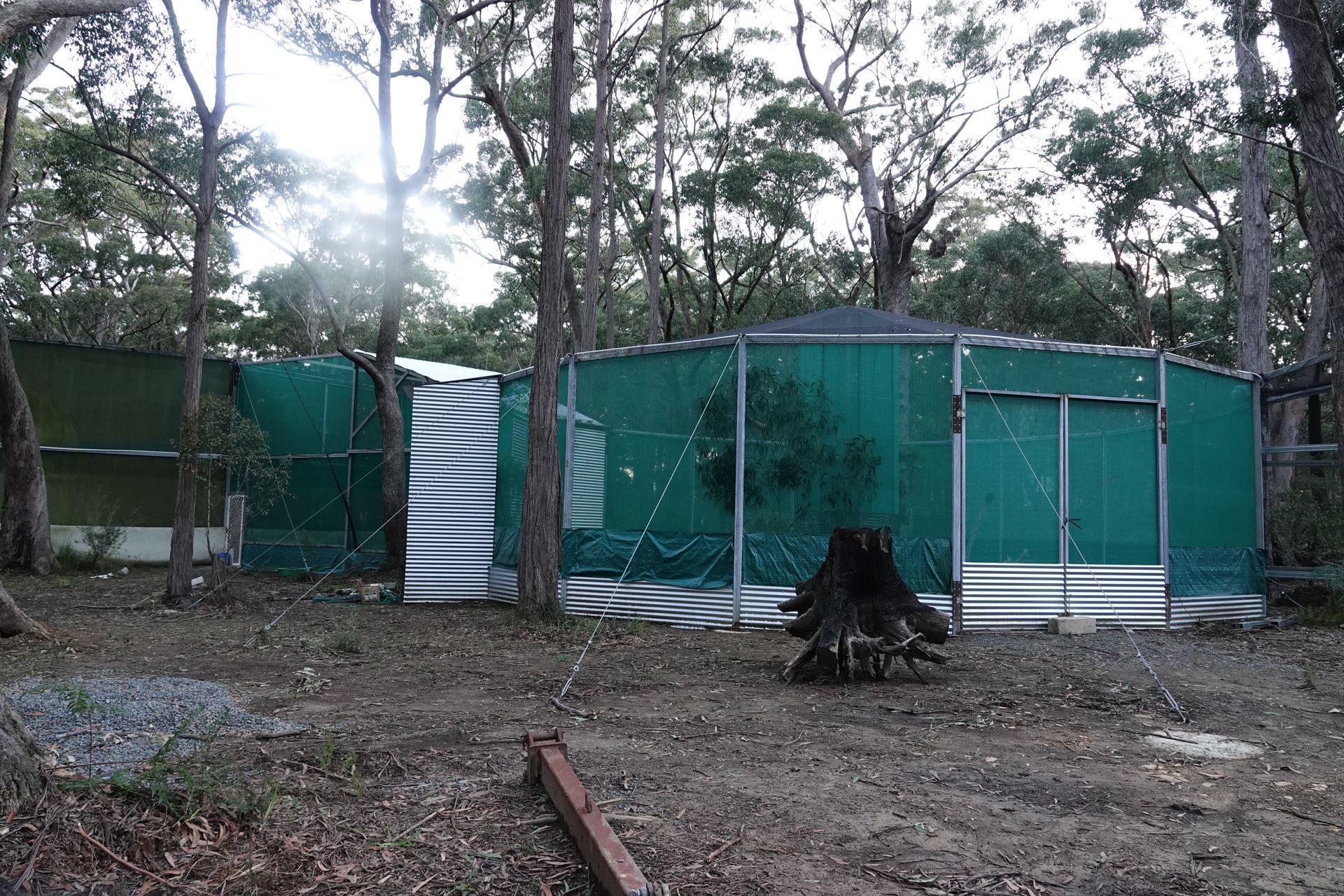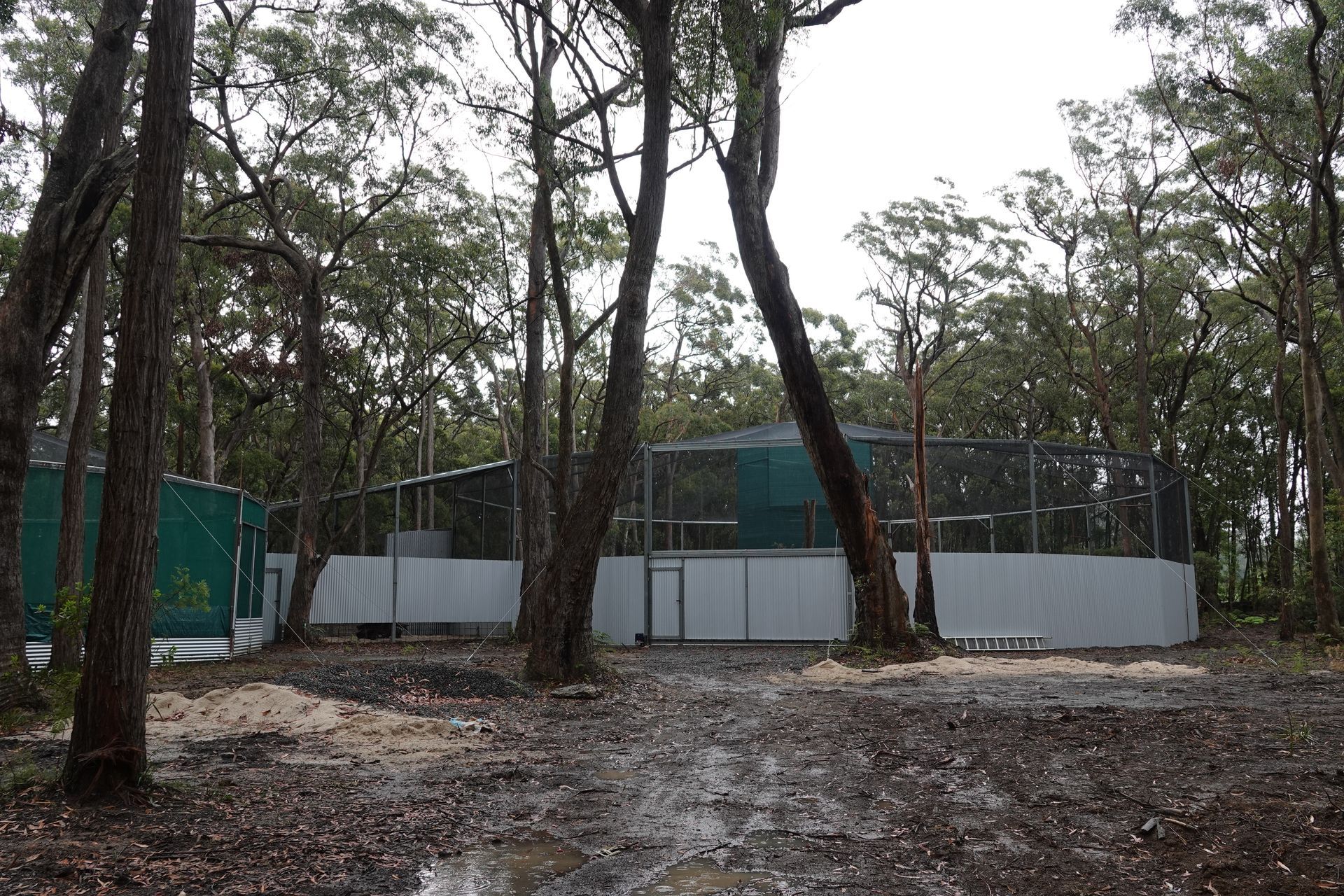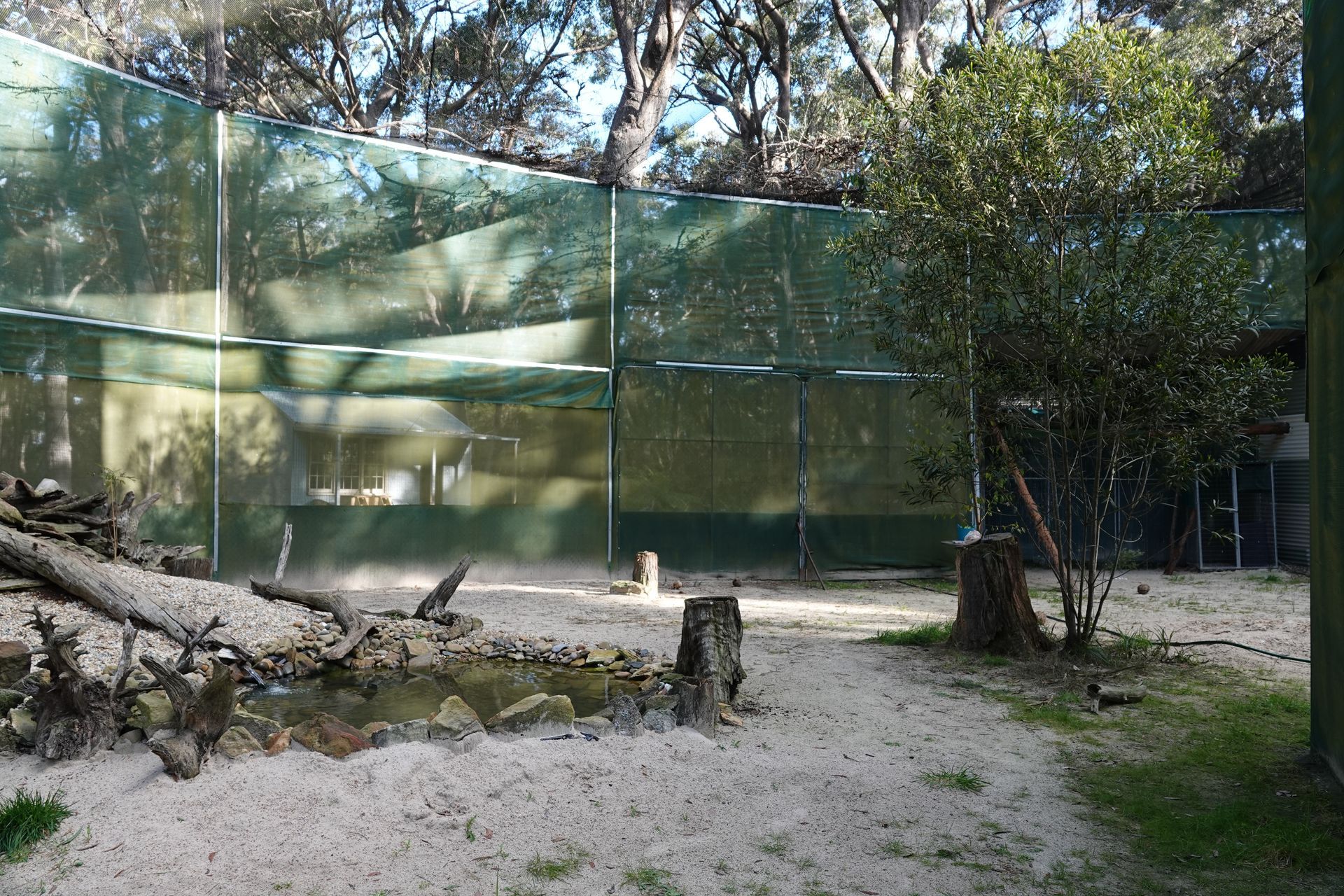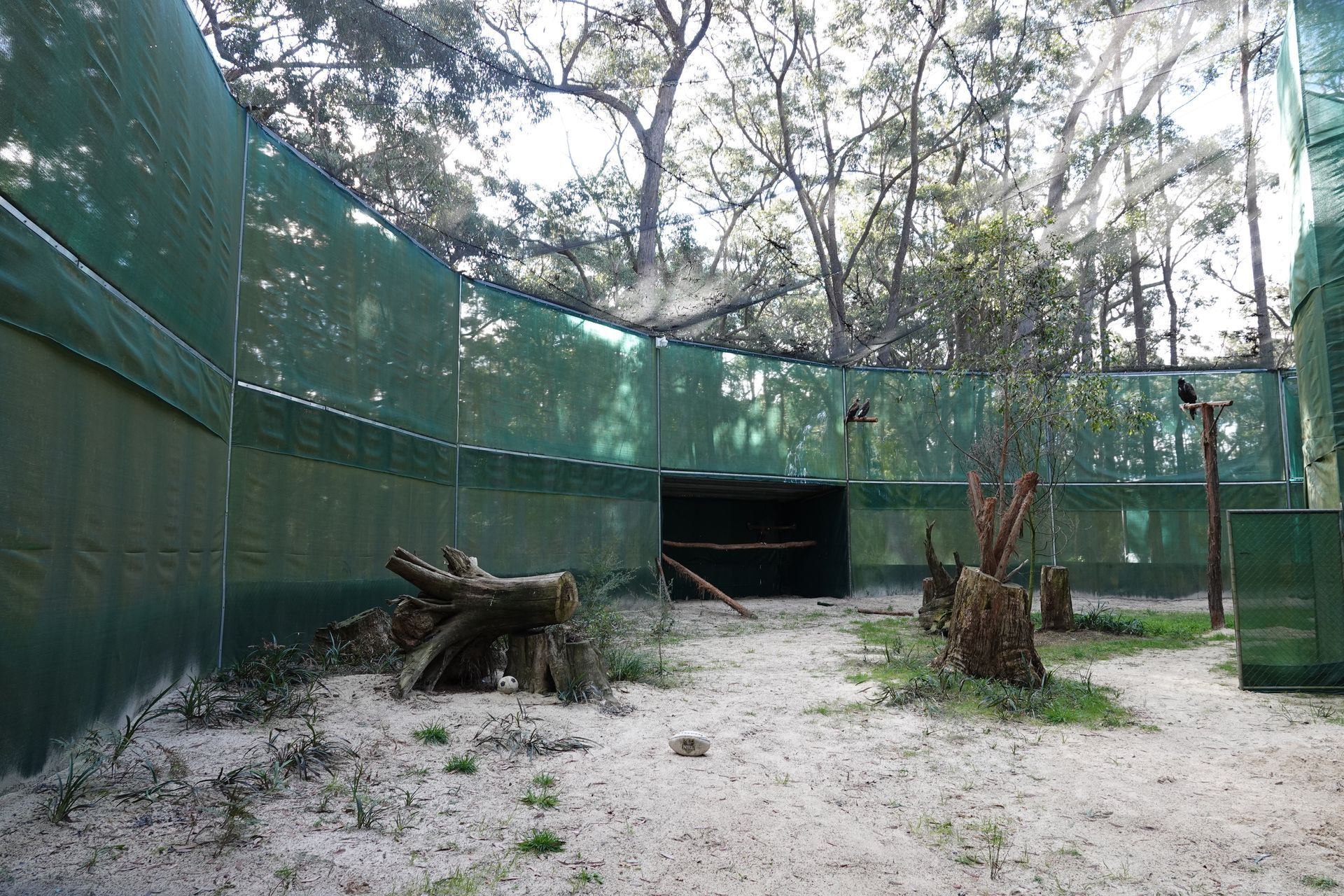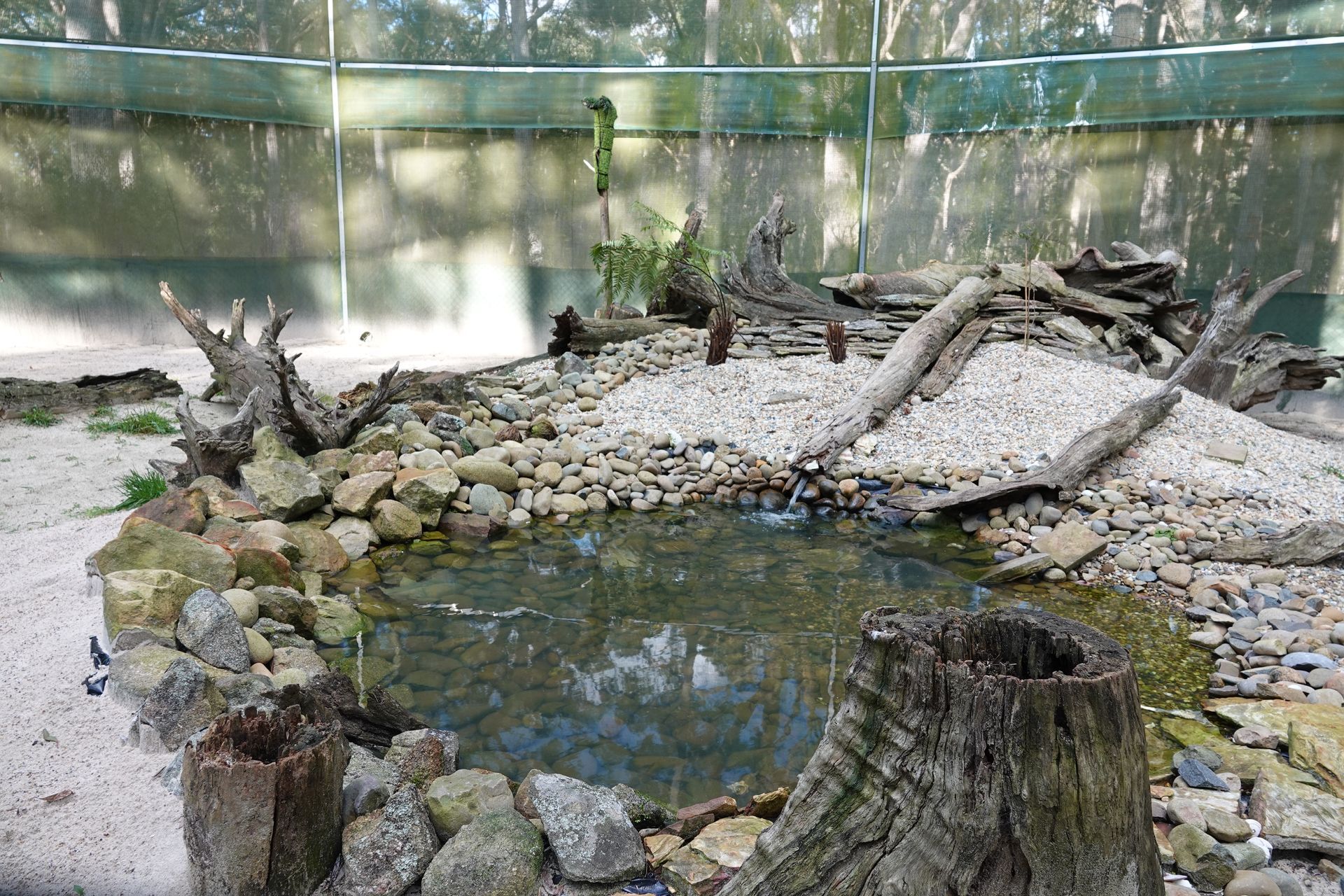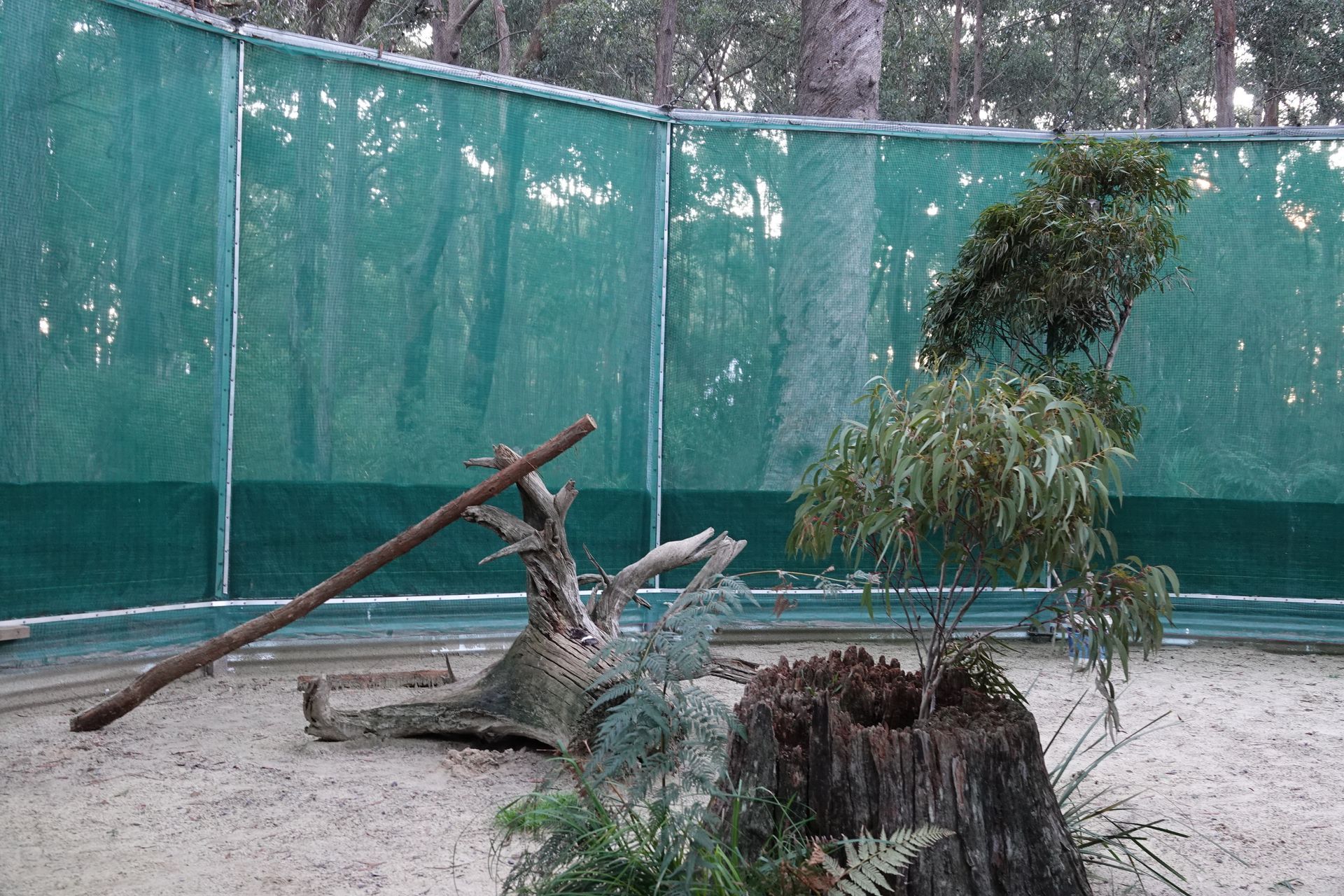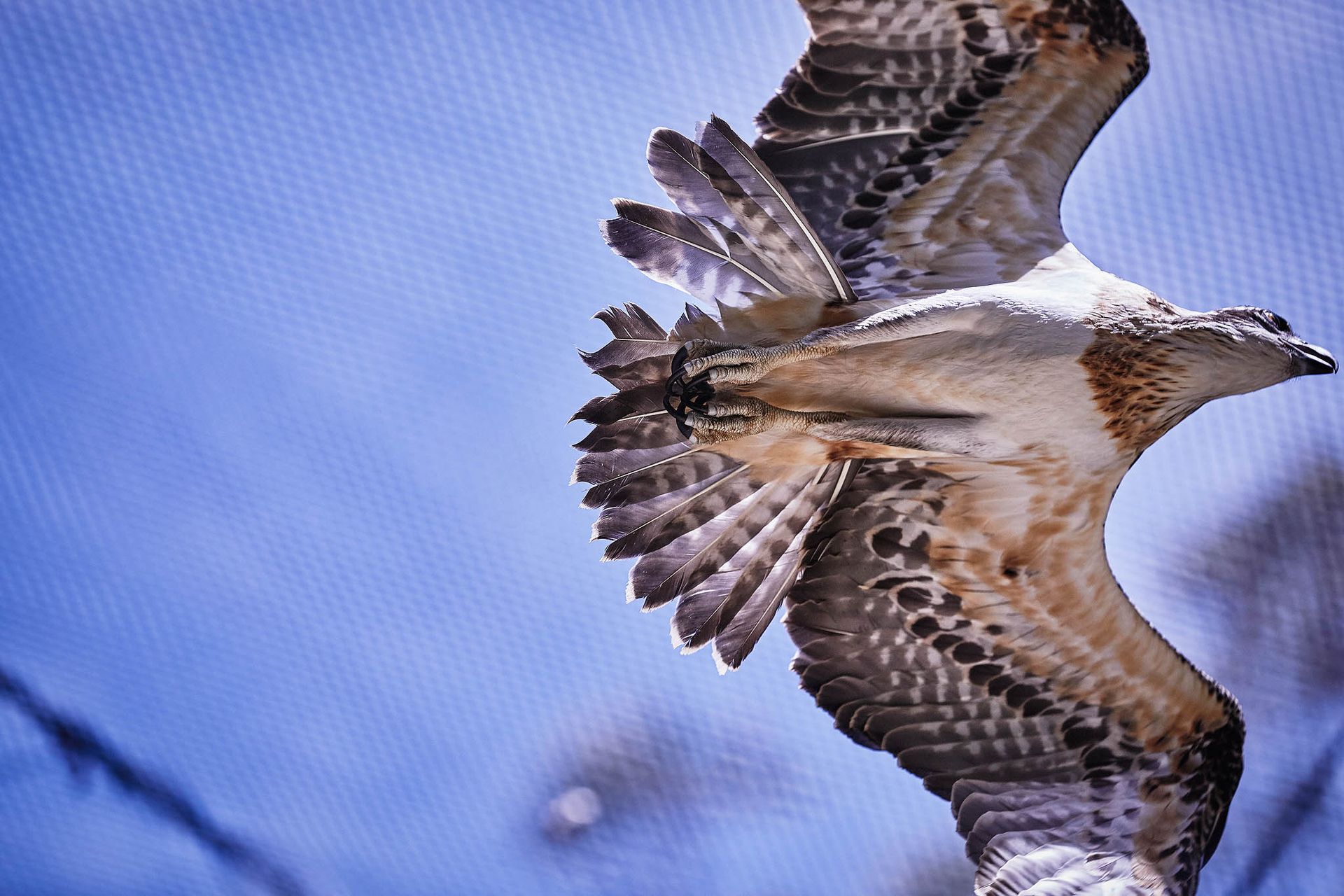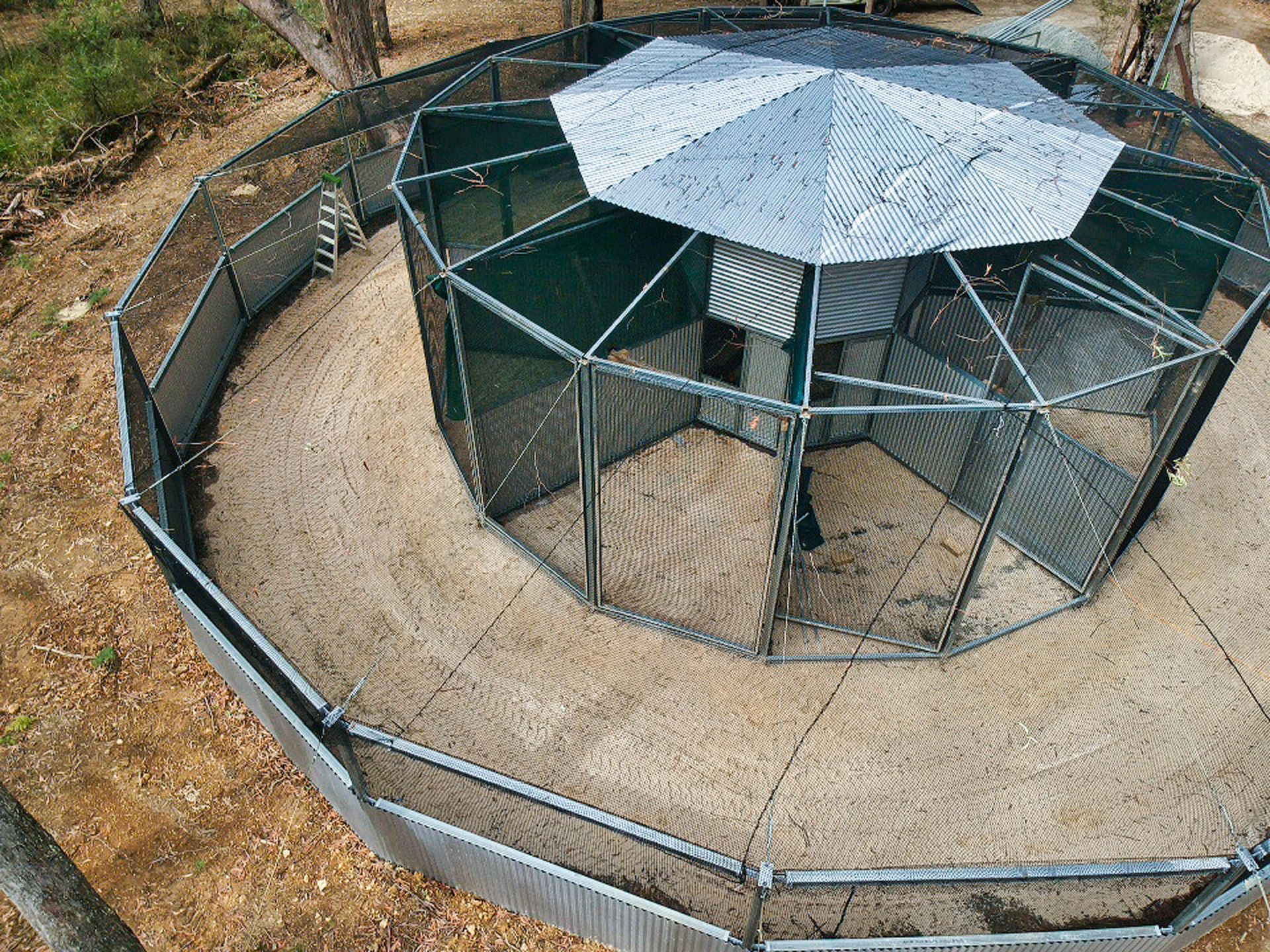AVIARY DESIGN
Pioneering, and advocating for continuing improvement in aviary design and construction in raptor rehabilitation
Photographer: Peg McDonald
“Birds are the most accomplished aeronauts the world has ever seen. They fly high and low, at great speed, and very slowly. And always with extraordinary precision and control.”
Sir David Attenborough
The Life of Birds (1998)
The following report features descriptions and images that were taken at, and describe, the Higher Ground Raptor Centre (HGRC) in the Southern Highlands of NSW, Australia over the years between 2012-2021. During this time the centre was created, constructed and continually improved by Peggy McDonald and Ross Robinson on what was then Peggy’s property and home.
For the first time, Australia had a dedicated raptor rehabilitation centre. This was home to more than 15 aviaries and other facilities, on par with the gold standard set by those seen by Peggy on her Churchill Fellowship journey to some of the best raptor rehabilitation spaces in the world.
ARCC Inc hopes this precedent will encourage the construction of similar aviary facilities around the country as greater understanding of these magnificent birds requirements prior to successful release is realised.
In mid-2021 and after the trauma of the bushfires, it was time for a new custodian. Peggy and Keith’s home and property were sold and the wonderful Odonata Foundation took over the guardianship role of HGRC, and have protected and recognised its importance since. Without them the centre may well not have survived, and Nigel and Lisa will always have Peggy’s enduring gratitude.
AViaries
The essential purpose of any aviary, no matter the size, is to provide appropriate space for the bird’s physical and mental condition.
As birds move through the facilities with the aviaries increasing in size, the ultimate aim is to provide an appropriate space at each stage of rehabilitation. Ultimately, this enables the bird to be released with a degree of fitness that allows it to both thrive and live normally back in its wild home territory.
These birds are the supreme athletes of the skies, the sky hunters, and along with that title comes the great responsibility on our part to make sure they are in excellent condition when we release them.
Feathers, body score, sight, hearing, wings, legs, feet and the ability to hunt, locomote, fly and breed normally when released are all critical factors that we must consider as part of our duty of care before we set a bird free again.
Here in NSW this is not only an ethical standpoint but also a legality set out in The Code: Code of Practice for Injured, Sick and Orphaned Birds of Prey | NSW Environment and Heritage
NSW, and some other states/territories, have minimum standard sizes for aviaries covering different stages of rehabilitation and species.
Factors such as cost, space, location and rehabilitator time constraints also need to be taken into consideration. It is appreciated that not everyone can have a 100m round aviary in their backyard, but we can all work within our budgets and limitations to build adequate and good holding facilities and pass on birds to more suitable amenities as their health improves.
This was always the initial focus of the HGRC, alongside providing a first class arrangement of facilities. The following descriptions briefly detail the major specialised structures, with images, of those at the Southern Highlands facility. The premises are also home to nine other smaller aviaries and an intensive care centre.
Round Aviaries
The author has been fortunate enough to complete five month-long internships at the Abu Dhabi Falcon Hospital (ADFH) between 2012 and 2018, as well as being awarded a Churchill Fellowship to study at some of the best raptor rehabilitation centres in the world, including the Carolina Raptor Center (North Carolina), The Raptor Center (University of Minnesota), Cobequid Wildlife Rehabilitation Centre (Nova Scotia), the Alaska Raptor Center (Sitka, Alaska), and the Moholoholo Animal Rehabilitation Centre (Hoedspruit, South Africa). The knowledge gained from these journeys has been invaluable in constructing a facility that meets world class standards.,
One of the many discoveries at the ADFH was their round free-flight aviaries. For decades it was debated that in Australia we were not giving our rehabilitated raptors the best chance to survive post-release due, in part, to the use of small rectangular aviaries. At the ADFH one round aviary was used as the first stage of reconditioning for hundreds of wild rehabilitated raptors (mostly falcons) released annually at migration time under the late HH Sheik Zayed’s falcon release programme.
One of the round aviaries at the Abu Dhabi Falcon Hospital, used for the pre-release conditioning of wild falcons. Gratitude to the ADFH for allowing this image to be used.

why round aviaries?
In order to ensure survival after release, we need to ensure that raptors in human care are fit and able to fly continuously, manoeuvre mid-air, hunt, take off, speed up and slow down their flight, brake and land.
Square or rectangular aviaries, while suitable for the early stages of rehabilitation, where the bird may not be particularly mobile, do not permit continuous flight or flight at speed, and therefore are not appropriate for preparing a raptor for release. Birds in these aviaries can only fly (if at all) from end to end, or one perch to another. For species that fly many hundreds of kilometres, or at speeds up to 70km/hr, this is insufficient.
A round aviary with a central pavilion removes the visual and physical barrier to flight, and allows and encourages birds to fly continuously in a circular fashion. The central pavilion may be used as a separate holding facility, but has the primary function of not enabling the birds, particularly the faster birds, to see an end point when flying. This encourages circular continuous flight rather than just back and forth, perch to perch.
Circular aviaries have been utilised for may years in the Middle East, both to maintain fitness in between seasons for highly prized hunting and racing falcons, as well as for raptors undergoing rehabilitation for release. Circular aviaries are also used in raptor rehabilitation in North America. The level of reconditioning and fitness achieved in this designs is far, far beyond what can be achieved in a square or rectangular aviary, regardless of size.
australia's first Round Aviary
The first round free-flight aviary based on the ADFH design was completed in 2014 after a rigorous fundraising effort. The Peter Spitzer Flight Aviary (PSFA) at the HGRC was and remains the first of its type in the Southern Hemisphere.
Photographer: Peg McDonald
It was adapted to suit the temperate conditions of the Southern Highlands: rain, frost, cold, hail (below) and the odd snowfall, instead of the intense heat and ferocious sand storms of Abu Dhabi!
Climate always needs to be taken into account when constructing aviaries. Whereas the aviaries at the ADFH have semi-solid walls and air-conditioning, the PSFA at HGRC has incorporated specialised netting that allows the passage of snow and rain through the roof to avoid build-up and overburden to the structure, and mesh and shadecloth for the walls that provides some visual barrier but permits critical airflow to maintain ventilation.
Photographer: Peg McDonald
construction
The PSFA is 100 m in circumference, 6m to 8m high and adjoins two traditional rectangular aviaries, 18 m x 5 m x 4 m in total (to the left of the picture). These can remain separate, be joined, or be opened to link and form one open complex with the birds having access to all areas.
Photographer: Peg McDonald
The roof is made with UV-resistant salmon netting. The walls utilised bird netting with a stainless steel thread running through, and lined with shade cloth. The lower third of the aviary walls have an additional layer of industrial webbing to provide privacy for birds on the ground stumps or in the pool. There are three bays with solid walls built in, for weather protection and variation in three-dimensional space.
Photographer: Mark Kelly
There is a personal access door for human use, as well as hinged vehicle access doors for machinery (only to be used when the aviary is unoccupied). The vehicle doors can be used for local soft releases as well.
Photographer: Peg McDonald
the second and third aviaries
Over the next seven years, two more circular aviaries were built adjoining the PSFA, as well as adjoining breezeways. The second aviary was made smaller, with half the diameter of the PSFA, and the third, the Wildlife Rescue South Coast Colley Family Aviary (CFA) had the same dimensions as the PSFA, but with some structural differences.
The differences are due to material availability and costing, but serve the same function. The lower half of the aviary walls are solid, the upper part black netting, which continues down to line the solid part to protect the birds, and there are two bays built into the wall around the circumference. As the lower walls are solid, there is no shade cloth used in the construction. The vehicle access door is a similar size to the PSFA, but opens by sliding and can be manually or electronically operated. The personal access door is incorporated in this larger door. The release door is separate to the vehicle access door, positioned in the upper half of the aviary wall, and is roughly 3m by 4m and heads into the bush and pasture.
The second smaller aviary sits between the PSFA and the CFA, is a smaller circular aviary 30 m in diameter. This aviary is similarly constructed with a black netting roof and walls, but with a layer of shade cloth lining the walls as well.
All three round free-flight aviaries are connected by a system of breezeways (with thanks to Wildlife Link and the Fairfax Foundation). These spaces can be left open to allow flight between aviaries, giving approximately 21,300m3 of flight space. They can also be closed off as needed, to create additional large rectangular aviaries, providing up to nine individual spaces of varying flight complexity depending on the configuration used.
Photographer: Peg McDonald
One of the essential design features of the round aviaries is the use of a central pavilion. The central pavilion of the aviary can be a separate holding facility, but its primary function is to prevent the birds, particularly fast birds, from seeing an end point when flying. This encourages continuous circular flight rather than just back and forth, from perch to perch, as seen in rectangular spaces.
Photographer: Peg McDonald
design features
The aviary floor is raised about 30cm from the surroundings, and the substrate base is a minimum depth of twenty centimetres of blue metal (gravel) to encourage drainage. A layer of washed river sand covers the entire base to a depth of around 30-40cm. This is easily spot-cleaned and raked over, and is a more hostile environment to pathogens than organic substrates such as soil. Sand is changed when needed, according to climate and use.
The aviaries contain natural furnishings such as wooden perches of varying types and dimensions, changed regularly and generally covered in Astroturf, stump and posts, logs, bushes and free flowing pools in the two large round free flights. Small established trees provide roosting sites and different flight pathways. Remember that in large free-flight aviaries the birds can be flying at great speeds and should not be landing onto inflexible perches that are hard and smooth. Avoiding the development of pododermatitis (bumblefoot) must always be a foremost consideration.
Each aviary is covered by wide view CCTV (with thanks to Vetafarm) allowing remote monitoring of all birds, multiple sprinkler systems, water and electricity access.
Detailed specs, materials, construction methods and videos of the birds in flight can be accessed at Higher Ground Raptor Centre's website, Higher Ground Raptors | Round Aviary
Photographer: Peg McDonald
As with all outdoor raptor housing, other factors that must always be taken into consideration include the following:
- Ventilation and light
- Weather protection and shelter
- Predator proofing
- Enrichment
- Water for bathing
- Water for drinking
- Substrate
- Feeding hatches
- Ease of access for machinery when needed
- Monitoring
Your state standards will also give information on these topics. If your state or territory does not have guidelines then we suggest following the excellent code published by the NSW Office of Environment and Heritage, with contributions by several experienced and knowledgeable raptor rehabilitators and veterinarians.
Code of Practice for Injured, Sick and Orphaned Birds of Prey | NSW Environment and Heritage
Photographer: Mark Kelly
The emergency response and Multi-purpose aviary
Following the bush fires of 2019/20 the land was parched all around the HGRC, there was a carpet of black leaves over the forest floor, embers burning and holes melted in the free flight roof. The fires had swung away with a wind change and missed the centre by less than 1 km.
The Wildlife Heroes Project, supported by the Foundation for National Parks and Wildlife, opened up grant applications for fire/emergency response related projects.
On three occasions over the season the centre had had to be evacuated - the first two times around 20 birds had been caught up and transported to shelter overnight at the Southern Highlands Veterinary Centre overnight, the third time the call for immediate evacuation came without warning and the birds had to be left. Thankfully the centre was saved by the last minute wind change and none of the birds were injured, but a repeat of that horrible experience would not be welcome.
One afternoon, pondering this problem, Ross Robinson and Peg McDonald first sketched on the ground plans for an emergency response and holding aviary. In times of impending natural disaster, birds could be housed in an aviary that both gave them a sense of freedom and allowed activity prior to evacuation, but also facilitated immediate capture, should evacuation be required at short notice.
The Emergency Response and Multi-Purpose Aviary (ERMPA) is the result of this initial sketch.
Photographer: Mark Kelly (right)
This aviary primarily functions as a space to safely hold birds and animals and allow for fast access and easy evacuation. However, as the idea became feasible it was obvious that it could be a lot more than just the original intention.
Further practical uses include:
- A quarantine space
- A holding facility for all types of creatures being looked after by carers in a fire,flood or natural disaster path to relieve them of that sense of being overwhelmed and allow them to concentrate on their personal and property well-being.
- A perfect orphan raising facility for birds unable to be reunited. A centre entrance allows access to the middle of the facility, and from that space each individual aviary has a door and feeding shute enabling birds to be fed without seeing a human.
- Normal aviary holding space with a front opening door to allow individual access to the free flight area, as well as the centre access.
Photographer: Mark Kelly
Construction materials consisted basically of steel and netting as used in the Colley family aviary, with a washed river sand base.
The aviary was designed as a pie shaped space with separate bays that house birds safely and spaciously, each bay with individual access to a circular flight. The lower half of each individual space, the space walls and the roof are steel sheeting. Netting as used in the Colley Family aviary is attached above the sheeting to the roof.
A unique and complex roof system was constructed by builder Ross to allow for the addition of 16 single bays and a walkway to the central area..
Each individual bay can be accessed from behind utilising a walkway that begins as a personal access door on the perimeter. Each has a private feeding shute, enclosed space for hack box and feeding shelf, perching system, access to the elements and individual exit with a large opening gate to the flight space.
ARCC Inc hopes this precedent will encourage the construction of similar aviary facilities around the country as greater understanding of these magnificent birds requirements prior to successful release is realised.
We are always happy to personally answer questions about the aviaries outlined in this report and their construction. Please contact us to find out more.
Photographer: Mark Kelly
Major contributors
Sincere gratitude is extended to the following organisations/people who have made major contributions towards the construction of the aviaries and contents described here.
In order of construction:
- Builder Ross Robinson, who embraced the project from the start and walked by my side from the very beginning to the end. Without his tenacity, generosity, abilities and patience, working alongside me to match what he could build for my needs I needed, none of this would have happened for a price that was achievable for me.
- Peggy McDonald OAM CF and WIRES Wingecarribbe who supported the construction of the first rectangular aviary back in the late 1990’s
- The late Bryce Courtney AM, and Rod Young for the financial and building support of the second rectangular aviary.
- WIRES, who collated donations and facilitated tax deductibility status for donors contributing to the PSFA which was largely funded by public donations and Wingecarribee Shire Council.
- The Tony and Lisette Lewis Foundation I WildlifeLink, who made major and crucial contributions that supported the centre through tough times, and for the construction of the small flight and breezeway. Special gratitude to Mr Richard Chadwick for facilitating the collaboration.
- James Fairfax AC and the Fairfax Foundation who also made significant and vital contributions to the small flight and breezeway constructions, as well as the centre in general.
- The Colley Family who raised an incredible sum of money through their six year old son selling his homemade clay koalas over in the USA as the fires were raging in NSW. Wildlife Rescue South Coast (WRSC) generously and kindly facilitated the transfer of these funds to support the whole build that was to become the CFA.
- Vetafarm, Tony and Kerry Gestier, who sponsored the Vetafarm CCTV system in its entirety and supplied nutritional and pharmaceutical products.
- Wildlife Heroes Programme sponsored through the National Parks and Wildlife Foundation, major contributors to the ERMPA.
fnpw.org.au/project/wildlife-heroes
- Humane Society International for supplying the massive water storage system which will help safeguard the centre into the future and holds an enormous supply of water for potential fire fighting, the water sprinklers each aviary has and general aviary water usage.
- Ms Deidre Hill, Ms Kerrie Farrell and Mr Theo Onisferou for their generous support and interest.
- WRSC, Adelle Scott and Sarah Tahourdin are thanked for helping and guiding me through the maze of the financial ins and outs, with WRSC facilitating tax deductibility status for donors and invoice payments.
- Every single person who donated and raised funds for the aviaries is gratefully thanked. The construction of this facility showed how every single dollar does eventually add up, and each donor has been recorded as part of the history of the HGRC. Together we all built a much-needed facility of which should be very proud.
Peggy McDonald OAM CF
In the spirit of reconciliation, Australian Raptor Care and Conservation Inc acknowledges the Traditional Custodians of country throughout Australia and their connections to land, sea and community. We pay our respect to their Elders past and present and extend that respect to all Aboriginal and Torres Strait Islander peoples today. We recognise and appreciate the traditional significance and cultural roles birds of prey play in the lives of our First Nations people.





